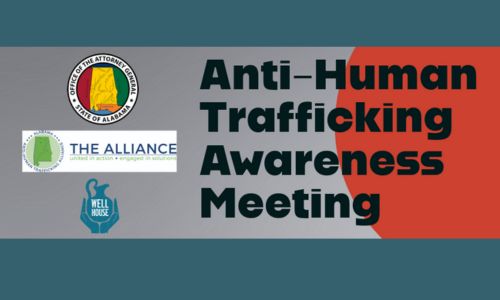Oxford, AL — The Oxford Civic Center was abuzz last night as it hosted a pivotal town hall event addressing the critical issue of human trafficking in Northeast Alabama. The gathering, which kicked off at 6:30 p.m., saw an impressive turnout of educators, parents, professionals, college students, church leaders, concerned citizens, and service providers, all coming together with a shared goal: to combat human trafficking in their community.
Organized collaboratively by the office of the Alabama Attorney General, the Alabama Anti-Human Trafficking Alliance, and The WellHouse—a nonprofit dedicated to providing safe spaces for survivors—the town hall served as a crucial platform for discussing the grim realities of human trafficking. The session featured brief presentations followed by an engaging Q&A segment, offering insights from an assistant district attorney, a law enforcement special agent, and a seasoned human trafficking service provider.
The evening began with an opening statement that underscored the importance of collaboration in tackling widespread societal issues. “My personal belief is that if there is any kind of massive problem in society, the best way to combat it is through collaboration,” the speaker asserted, setting a collaborative tone for the event. The discussion highlighted the need for community involvement and awareness, aiming to dispel prevalent myths about human trafficking.
A significant myth addressed was the belief that human trafficking primarily involves strangers abducting victims. Panelists clarified that trafficking often involves grooming and manipulation, with victims sometimes being lured by traffickers under false pretenses. Jaclyn Willis, an investigator with the East Metro Area Crime Center, explained, “Right now, a lot of what we’re seeing is that kids are being groomed online. They think they’re meeting a friend, but they end up trapped in a situation they can’t easily escape.”
The panel also shed light on the disturbing issue of familial trafficking, where family members sell other family members into trafficking. This shocking revelation resonated deeply with attendees, with one speaker noting, “It’s something we don’t fathom, and because of that, we don’t always realize it’s happening in our own communities.”
Throughout the evening, attendees were encouraged to be vigilant about their children’s online activities and to educate themselves and others about the signs of trafficking. The message was clear: trafficking can occur anywhere, including small communities, and everyone plays a role in preventing it.
The town hall ended with a powerful call to action: to educate, to stay aware, and to support survivors. The speakers emphasized that the fight against human trafficking is a collective responsibility that requires active participation from every community member.
The event highlighted several key points:
- Educational Resources: The National Center for Missing and Exploited Children (NCMEC) and the Blue Campaign by Homeland Security provide valuable resources, including age-appropriate videos and informational pamphlets to educate about human trafficking and online safety.
- Communication and Awareness: Effective communication about trafficking signs is crucial. Educating children, family members, and friends, and staying updated on new apps and online trends are essential for prevention and identification.
- Reporting and Support: Suspected trafficking cases should be reported to law enforcement rather than relying on social media or unverified sources. Compassion and support for victims are critical, as they may face societal judgment or dismissal.
- Understanding Vulnerabilities: Traffickers often exploit victims’ vulnerabilities, such as broken homes or being unaccompanied minors, through manipulation and false promises.
- Labor Trafficking: Labor trafficking, involving debt bondage, often affects migrants and is prevalent in industries like agriculture and massage parlors. This type of trafficking is less visible but widespread.
- Law Enforcement and Victim Support: A compassionate and informed approach is necessary in addressing both sex and labor trafficking. Understanding victims’ backgrounds and offering support without judgment are key.
The discussion also covered specific indicators of sex trafficking, including:
- Attendance Patterns: Frequent absences on specific days may indicate trafficking. Monitoring attendance patterns can help identify potential cases.
- Truancy Initiatives: Programs like the “Helping Families Initiative,” involving truancy officers in schools, can aid in identifying trafficking cases through attendance monitoring.
- Behavioral Changes and New Items: Sudden changes in behavior or new clothing and items may signal manipulation or grooming by traffickers.
- Relationship Dynamics: Expensive gifts or experiences from new relationships may indicate trafficking involvement.
During the Q&A segment, several questions were addressed:
- Dealing with a 15-Year-Old Grandson: Balancing safety with giving space can be challenging. Prioritizing the child’s well-being and encouraging open communication are essential.
- Educating Children About Real-World Dangers: Gradually introducing age-appropriate information and ensuring open lines of communication can help educate children about dangers without being overbearing.
- Signs of Trafficking in Healthcare: Healthcare professionals should look for signs like lack of identification and dependence on others for information. Reporting suspicions to law enforcement is crucial.
- Handling Suspected Trafficking Cases: Reporting to trained professionals and documenting unusual signs is vital. Utilizing resources like trafficking hotlines can provide support.
- Becoming an Advocate: Individuals interested in advocacy can connect with organizations like Trafficking Hope and participate in relevant training and educational courses.
The Oxford Civic Center town hall served as a powerful reminder that human trafficking is not solely a problem for law enforcement or social services but a community-wide issue demanding a community-wide response. The event underscored the importance of education, vigilance, and collaboration in the ongoing fight against human trafficking.









